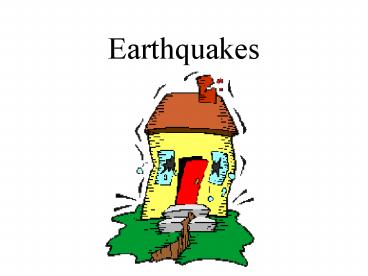Earthquakes - PowerPoint PPT Presentation
1 / 28
Title:
Earthquakes
Description:
Earthquakes. While going over the notes, answer the following questions. ... Idaho is part of many different fault systems and has many earthquakes per year. ... – PowerPoint PPT presentation
Number of Views:361
Avg rating:3.0/5.0
Title: Earthquakes
1
Earthquakes
2
While going over the notes, answer the following
questions.
1. What happens at a strike slip fault to cause
an earthquake? 2. What is the focus of an
earthquake? How is it different from the
epicenter of the earthquake?
3
REVIEW QUESTIONS
3. Describe the movement and speed of
P-waves. 4. Describe the movement and speed of
S-waves. 5. Why do L-waves cause more
damage than S- or P-waves?
4
REVIEW QUESTIONS
6. Where did the largest magnitude earthquake
occur in the state of Idaho? 7. What is the
Nisqually event? 8. What is the difference
between magnitude and intensity of
earthquakes? What scales are used to measure each?
5
Elastic Rebound Theory
- Rocks on each side of
- fault are moving slowly
- Sometimes rocks will
- stick and lock together
6
Elastic Rebound Theory
- Builds up stress in the
- rock causing strain
- Rocks will eventually fracture
- and rest of rock layer will
- rebound back into
- their normal shape
7
San Andreas Fault
The motion of the rock on one side of a fault in
ththe opposite direction from the other side of
the fault
8
Sites of Earthquakes
The FOCUS of an earthquake is the point in the
Earth's interior where stress is released and
rocks move. Waves move outward away from this
area.
9
Sites of Earthquakes
The EPICENTER is the place along the surface of
the earth, above the focus, where the
earthquake feels the strongest.
10
(No Transcript)
11
TYPES OF SEISMIC WAVES
PRIMARY are the first waves to arrive at a
seismograph station.
12
TYPES OF SEISMIC WAVES
PRIMARY Are the fastest form of wave, sometimes
called compression waves.
13
TYPES OF SEISMIC WAVES
PRIMARY These waves cause rock particles to move
back and forth in the same direction as the
wave is traveling.
14
TYPES OF SEISMIC WAVES
PRIMARY Can move through any material found
inside the earth (lithosphere, asthenosphere,
core)
15
TYPES OF SEISMIC WAVES
SECONDARY arrive after the primary waves at the
seismograph station.
16
TYPES OF SEISMIC WAVES
SECONDARY Can travel through solids but not
liquids. Are sometimes called a sine waves.
17
TYPES OF SEISMIC WAVES
SECONDARY Cause particles to move back and forth
at right angles to the line of wave movement.
18
TYPES OF SEISMIC WAVES
SECONDARY Can only move through solid rock so
will not pass through the inner core, outer
core, or asthenosphere.
19
TYPES OF SEISMIC WAVES
SURFACE (LAND) Travel along the outer surface of
the earth at slower speeds.
20
TYPES OF SEISMIC WAVES
SURFACE (LAND) Rock particles move like waves
would move in water, in a circular motion.
21
TYPES OF SEISMIC WAVES
SURFACE (LAND) Cause most of the destruction
during an earthquake.
22
TYPES OF SEISMIC WAVES
SURFACE (LAND) Deep focus quakes will usually
produce small surface waves Shallow focus quakes
will usually produce large surface waves
23
Earthquakes in Our Area
- Idaho is part of many different fault systems and
has many earthquakes per year.
24
(No Transcript)
25
Idaho Earthquakes
26
(No Transcript)
27
Earthquake Measurement
28
Earthquake Measurement































